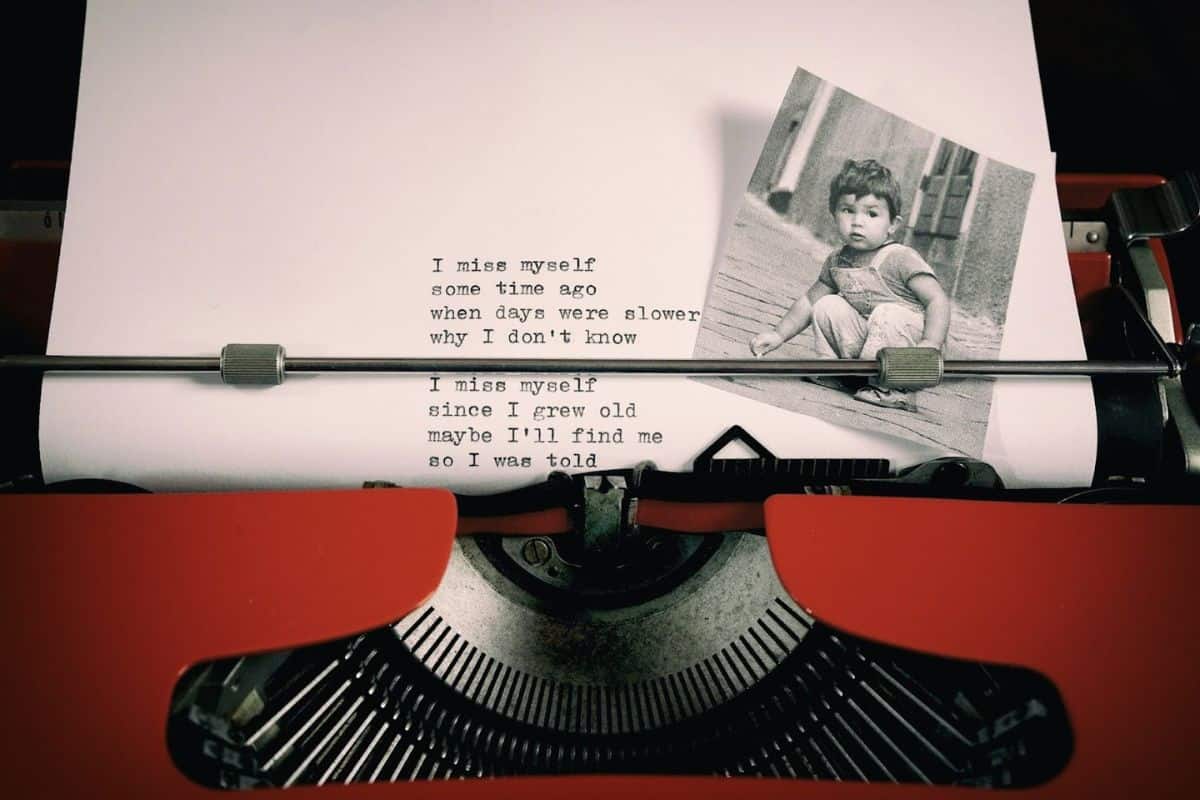Writers have used poetry to build strong feelings, narrate their stories and express ideas with the words they have selected.
Despite the rules in traditional poems, free verse poems allow the poet to feel and express a wide range of feelings.
This article covers the features of a free verse poem, how it is written and gives insight into composing one.
What Is a Free Verse Poem?
What is a free verse poem? A free verse poem is a type of poem without a set rhyme, meter or musical shape.
Instead, free verse poems use the writer’s natural way of speaking and a feel for when to pause.
By “free,” we mean not being bound by the hard rules which is common in most traditional poetry.


Never Worry About AI Detecting Your Texts Again. Undetectable AI Can Help You:
- Make your AI assisted writing appear human-like.
- Bypass all major AI detection tools with just one click.
- Use AI safely and confidently in school and work.
A lot of poets looked for creative ways to go past popular poetry styles, and as such, free verse poetry became popular in the late 19th and early 20th centuries.
It is often said that Walt Whitman helped invent free verse when his important work “Leaves of Grass” appeared in 1855.
Knowing what is a free verse poem definition centers on lacking fixed patterns instead of possessing specific elements.
However, this doesn’t mean free verse lacks structure altogether. How the poem is structured comes from its content, mood and goals.
In free verse, the speaker’s language and the poet’s pauses are what give the words rhythm.
Free Verse vs. Traditional Poetic Forms
To learn what sets free verse apart from traditional forms, it is important to consider the following points:
These traditional types of poetry, such as sonnets and villanelles, follow a regular stress pattern using alternating syllables (with a typical rhyme) and set rules about line length.
Free verses, by contrast, feature different rhythms at every beat, only a few may rhyme, the form is not fixed and they have general structures that do not conform to external rules.
That doesn’t mean that what is free verse in a poem is just regular prose written in lines.
Imagery, metaphors, various sounds and unpredictable line breaks are what give free verse a poetic nature.
Is Free Verse Really Poetry? Debunking the Debate
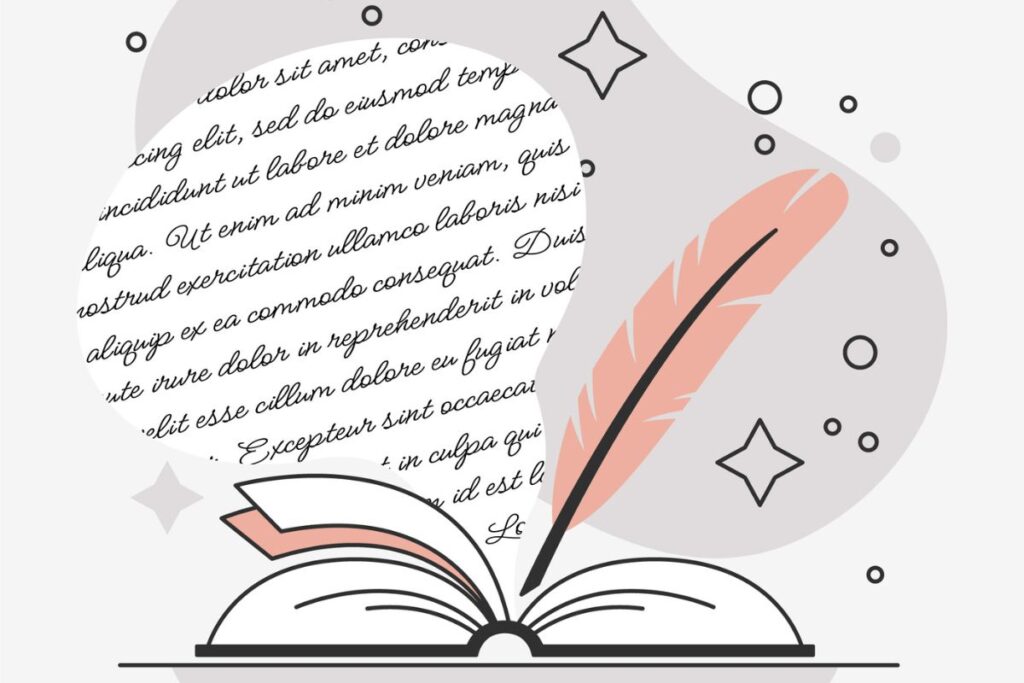
Since its emergence, free verse has faced criticism from traditionalists who question whether poetry without regular meter and rhyme can truly be considered poetry.
This debate has persisted for over a century, with many arguing that the absence of formal constraints makes free verse merely “chopped-up prose.”
Still, this belief does not take into consideration either the essence of poetry or the effort put into creating good free verse.
Along with its form, poetry is shaped by its use of language, feelings, sound, emotional resonance, images and overall meaning.
Decisions such as how long lines are, where to put breaks, the choice of rhythms and word sounds set free verse apart from prose.
By the end of their discussions, literary scholars agreed and came to a consensus that free verse poetry did count as poetry.
In reality, many of the best examples of poetry from the late 1900s and the present are written in free verse.
Since there are no fixed structures in free verse, poets rely on imagination to help readers understand what they’ve written.
Characteristics of Free Verse Poetry
Although free verse does not follow all the usual rules, it has various characteristics that make it different from other types of writing.
Let’s look at some key features that help answer the question:
What is a free verse poem?
- Natural Speech Rhythms: Free verse often follows the patterns of natural speech rather than artificial metrical schemes. This creates an intimate, conversational quality that can feel more intimate than highly structured forms.
- Purposeful Line Breaks: While line breaks in prose are set by page width, free verse poets decide where to stop a line themselves. As a result, you can highlight particular words and decide the speed and sound of your reading as well as make the sentences look attractive on the page.
- Varied Line Lengths: Free verse embraces irregular line lengths that may shift dramatically within a single poem. This variability helps to enforce the poem’s meaning and emotional impact.
- Sound Devices: Although it doesn’t need rhyme, free verse poetry may still include sounds like repetitions of vowels (assonance), consonants (consonance) or the use of the same initial consonant in several words (alliteration).
- Imagery and Figurative Language: Just as with poetry, free verse is deepest when it includes striking images and unusual language to give the poem more than one meaning.
- Typographical Innovation: Free verse poets often experiment with spacing, indentation, and other visual elements to reinforce meaning and guide reading.
As a result, these characteristics ensure that poems become not only comfortable and pleasing, but also made with attention and intention.
But if originality isn’t easy for you, our Undetectable AI’s AI Humanizer will take care of it for you, ensuring your description of abstract literary concepts uses a genuine tone.
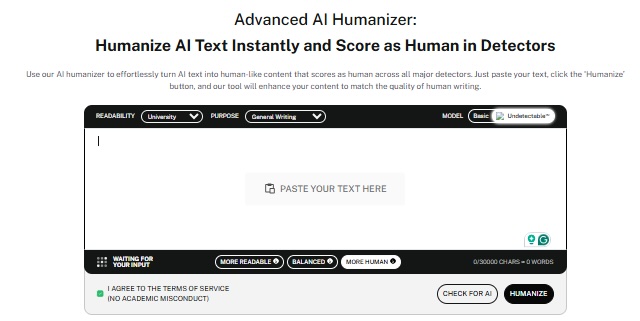
Famous Examples of Free Verse Poems
What is a free verse poem examples that showcase the form’s power and versatility?
Here are several influential free verse poems that demonstrate different approaches to the form:
- “Song of Myself” by Walt Whitman: Whitman’s sprawling, expansive lines celebrate the individual and collective American experience through a voice that sounds conversational yet elevated:
“I celebrate myself, and sing myself,
And what I assume you shall assume,
For every atom belonging to me as good belongs to you.”
You can observe that the lines in this poem are lengthy and flowing, just as our everyday speech tends to be and the repetition rather than rhymes creates the harmony.
- “The Red Wheelbarrow” by William Carlos Williams: Williams demonstrates how free verse can be extremely concise and imagistic. Below is a part of the poem:
“so much depends upon
a red wheel barrow glazed with rain water
beside the white chickens.”
The unusual line breaks and stanza divisions create visual and rhythmic effects impossible in traditional forms.
- “Howl” by Allen Ginsberg: Ginsberg uses very long and repeating lines to show how excited and frantic contemporaries of his generation were:
“I saw the best minds of my generation destroyed by madness,
starving hysterical naked,
dragging themselves through the negro streets at dawn looking for an angry fix…”
- The Waste Land” by T.S. Eliot: Eliot’s modernist masterpiece incorporates multiple voices, languages, and rhythms in its fragmented meditation on post-war civilization. Below is a snippet:
“April is the cruellest month, breeding
Lilacs out of the dead land, mixing
Memory and desire, stirring
Dull roots with spring rain.”
- “Diving into the Wreck” by Adrienne Rich: Rich uses free verse to explore themes of identity and discovery as you can see below:
“I came to explore the wreck.
The words are purposes.
The words are maps.
I came to see the damage that was done
and the treasures that prevail.”
The four examples, from Whitman’s long catalogs to Williams’ brief images, Ginsberg’s passionate writing and Eliot’s thoughtful style, all demonstrate how wide and powerful free verse can be.
Why Poets Choose Free Verse
Poets turn to free verse for numerous reasons, many of which relate to the form’s unique expressive possibilities, such as:
- Authenticity: Because poets can mold the form to fit the content, free verse avoids the sense of forced structure that some poetry has. Poets can express their ideas and emotions by following how they naturally have energy, instead of structuring their thoughts. Because the words are true to experience, readers can relate to what the poet says.
- Contemporary Expression: Without the archaic-sounding patterns of traditional forms, free verse can address modern subjects in modern language. The absence of rigid metrical requirements means poets can incorporate contemporary speech patterns, slang, technical terminology, and cultural references that might be difficult to fit into conventional forms.
- Accessibility: Anyone new to poetry can use free verse to express themselves, without first learning complicated rules of form associated with conventional poetry. Thus, more people than before can explore poetry, since they will not have to face the intimidating rules used in typical poetry forms. It’s more important for new poets to find their voice than it is to carefully structure their poems.
- Flexibility: Free verse works in many different situations, emotions and scenarios. It has room for the intimate tone of love, the passion of political writing, the colorful playfulness of word use and for moments that are disconnected and dreamlike. This is mainly because it covers so many styles and expresses all aspects of humanity.
- Innovation: The form encourages experimentation and the development of new poetic techniques. When the usual patterns are absent, poets must think carefully about everything they write and how it will look on the page. Noticing more about themselves usually opens the door to creativity and changes in the art of poetry.
This doesn’t mean free verse is superior to formal poetry, as both have their place.
Many accomplished poets work in both traditional and free forms, choosing the approach that best serves their specific artistic goals.
How to Write a Free Verse Poem
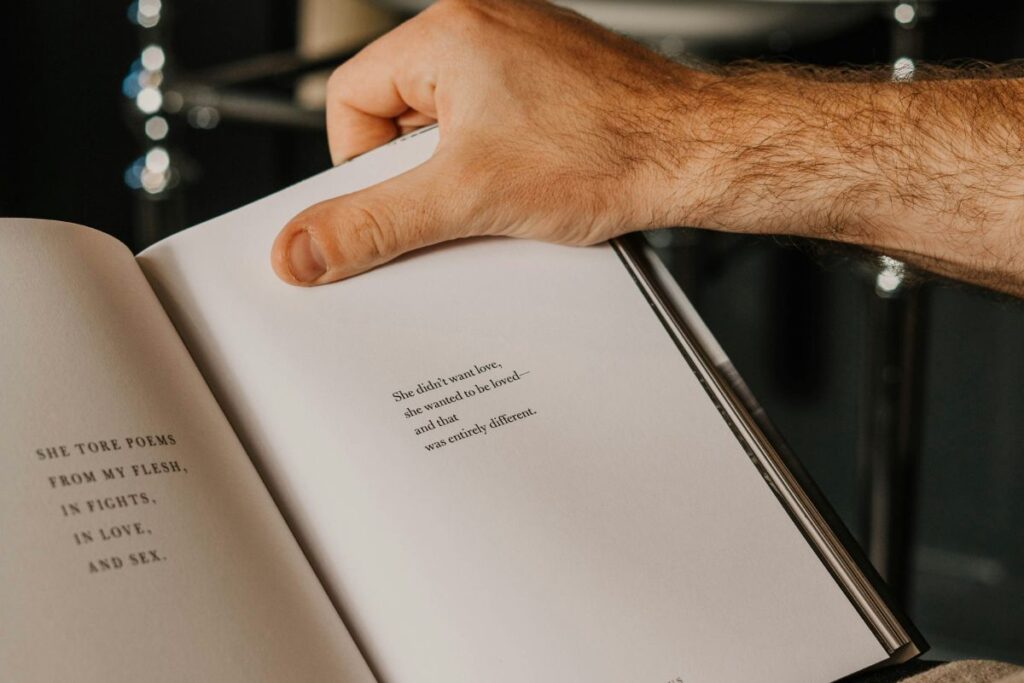
Here are helpful tips on how to write a free verse poem
Choose a Subject or Emotion
Begin by understanding that free verse doesn’t mean “anything goes.”
Effective free verse creates meaning by how it puts together choices, from the words to the way the lines are divided to the layout and shape of the verses on the page.
Having an idea or emotion that you want to pick up can help your writing.
This can refer to an event from your life, something you notice in nature, a comment on society or an idea that is not easily noticed.
Having a specific focus will give your poem direction and purpose.
Gather Sensory Details
Find notes on the senses such as color, smell, texture and sound, that apply to your main idea.
What are the senses you get when you have food? Free verse makes full use of imagery to affect all the senses of the reader.
Record every piece of information you can, even if you aren’t sure you will be using it all.
If you are writing about anxiety, you may mention physical signs such as drumming fingers on a table or taking very shallow breaths.
Arrange Words Into Lines
As soon as you have your raw material, start placing your words to form lines.
In writing free verse, line breaks guide your reading speed, give importance to highlighted words, shape the poem’s appearance and help build rhythm.
Don’t feel compelled to create complete sentences or to break lines only at natural pauses.
Experiment with breaking lines in unexpected places to create tension or emphasis.
Pay Attention to Sound
Be aware of how your words sound in your poetry.
Even though free verse doesn’t follow a pattern of rhythm and rhyme, it often makes its musical qualities by including alliteration (repeated consonant sounds), assonance (repeated vowel sounds) and consonance (repeated consonant sounds with different vowels).
Structure Your Stanzas
Decide how many lines will be in each stanza. Just as paragraphs do in prose, stanza breaks in free verse help make it clear that the subject (or feeling) is changing.
You can either use one stanza for introspective meditation or use several to highlight differences or progress. How your poem looks on the page plays a role in how it affects readers.
Revise with Intention
After crafting your initial draft, step back and evaluate its effectiveness.
Does every word earn its place? Have you avoided clichés and generic language? Does the form serve the content? Cut any lines that seem redundant or replace vague words with more precise ones.
Often, the revision process is where free verse truly takes shape, as you refine your choices about language and structure.
You can use our Undetectable AI Chat to create an exceptional poem while paying attention to your authentic voice, if you want to easily create your free verse poetry without going through these steps.
All you have to do is input your prompt and let the AI do the work for you.
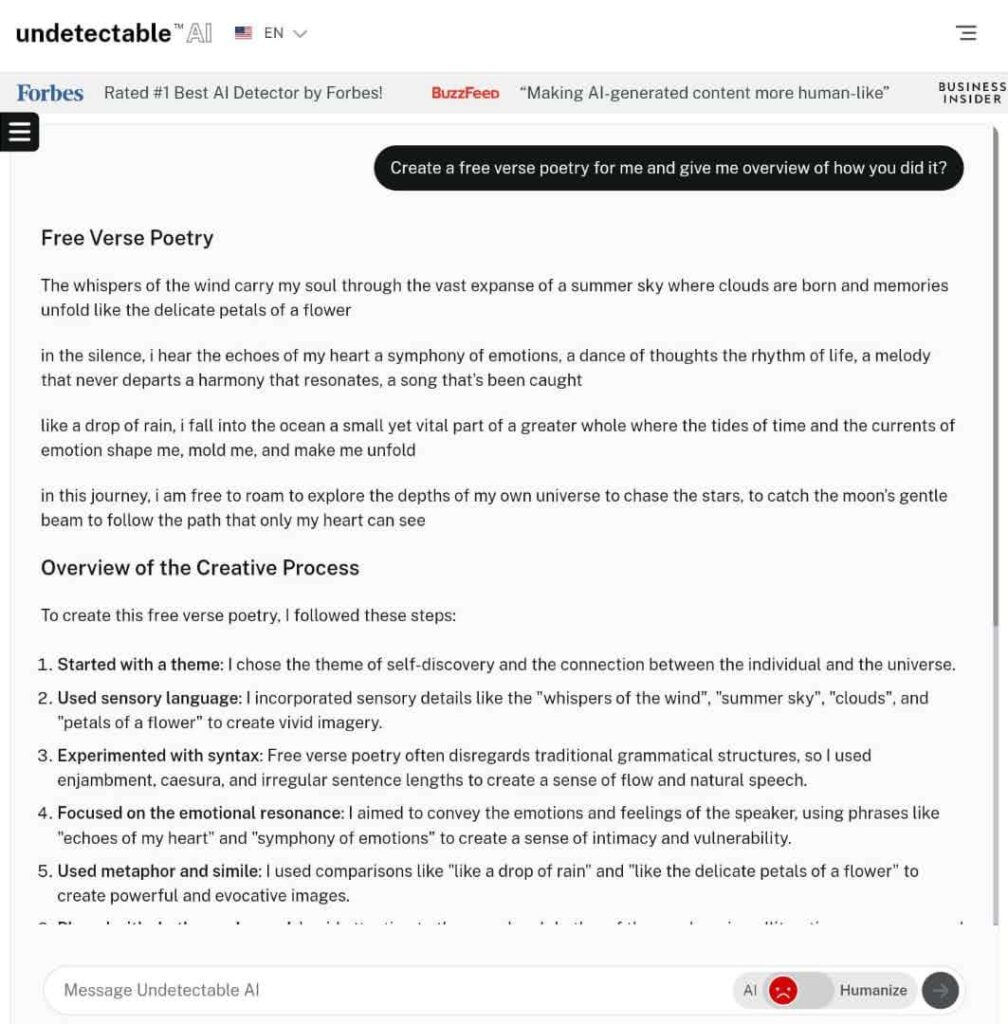
Lastly, if you want a little help shaping your ideas into lines that feel natural and rhythmic, you can try our Undetectable AI Poem Generator to explore how free verse patterns might flow on the page.
It gives you an easy way to experiment with line breaks, pacing, and voice before you begin refining your own draft.
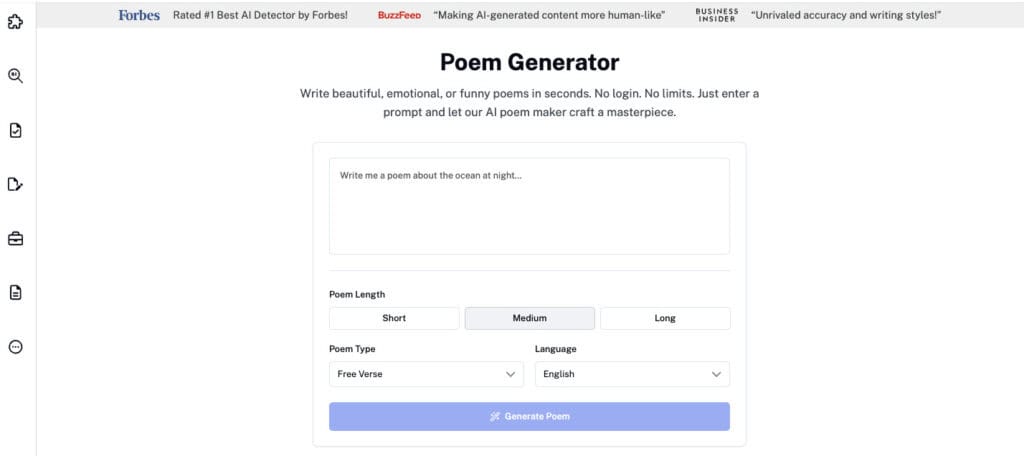
Start exploring—our AI Detector and Humanizer are waiting in the widget below!
Conclusion
Free verse poetry offers a powerful medium for modern self-expression by combining artistic freedom with poetic discipline.
If you want to create your own free verse poetry but are concerned about maintaining a genuine voice, try our Undetectable AI Humanizer tool today to ensure your poetic expressions remain authentic and discover the liberating experience of poetry without boundaries.
